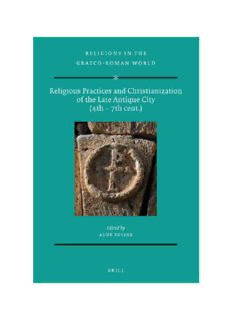
Religious Practices and Christianization of the Late Antique City (4th – 7th Cent.) PDF
Preview Religious Practices and Christianization of the Late Antique City (4th – 7th Cent.)
Religious Practices and Christianization of the Late Antique City (4th–7th cent.) Religions in the Graeco-Roman World Series Editors David Frankfurter (Boston University) Johannes Hahn (Universität Münster) Frits G. Naerebout (University of Leiden) VOLUME 182 The titles published in this series are listed at brill.com/rgrw Religious Practices and Christianization of the Late Antique City (4th–7th cent.) Edited by Aude Busine LEIDEN | BOSTON Religious practices and Christianization of the late antique city (4th-7th cent.) : / edited by Aude Busine. pages cm. — (Religions in the Graeco-Roman world, ISSN 0927-7633 ; VOLUME 182) Includes bibliographical references and index. ISBN 978-90-04-29460-8 (hardback : alk. paper) — ISBN 978-90-04-29904-7 (e-book : alk. paper) 1. Religious life—History—To 1500. 2. Cities and towns—Religious aspects. 3. Christianity—Influence. I. Busine, Aude, editor. BL624.R428 2015 200.9173’209015—dc23 2015014834 This publication has been typeset in the multilingual “Brill” typeface. With over 5,100 characters covering Latin, ipa, Greek, and Cyrillic, this typeface is especially suitable for use in the humanities. For more information, please see brill.com/brill-typeface. issn 0927-7633 isbn 978-90-04-29460-8 (hardback) isbn 978-90-04-29904-7 (e-book) Copyright 2015 by Koninklijke Brill nv, Leiden, The Netherlands. Koninklijke Brill NV incorporates the imprints Brill, Brill Hes & De Graaf, Brill Nijhoff, Brill Rodopi and Hotei Publishing. All rights reserved. No part of this publication may be reproduced, translated, stored in a retrieval system, or transmitted in any form or by any means, electronic, mechanical, photocopying, recording or otherwise, without prior written permission from the publisher. Authorization to photocopy items for internal or personal use is granted by Koninklijke Brill nv provided that the appropriate fees are paid directly to The Copyright Clearance Center, 222 Rosewood Drive, Suite 910, Danvers, ma 01923, usa. Fees are subject to change. This book is printed on acid-free paper. Contents List of Figures vii 1 Introduction: Religious Practices and Christianization of the Late Antique City 1 Aude Busine 2 Christianisme antique et religion civique en Occident 19 Claire Sotinel 3 Les lieux du polythéisme dans l’espace urbain et le paysage mémoriel d’Antioche-sur-l’Oronte, de Libanios à Malalas (IVe-VIe s.) 38 Catherine Saliou 4 Holy Goals and Worldly Means. Urban Representation Elements in Church Complexes 71 Ine Jacobs 5 Public Rituals of Depaganization in Late Antiquity 115 Johannes Hahn 6 Lingering Sacredness. The Persistence of Pagan Sacredness in the Forum Romanum in Late Antiquity 141 Kristine Iara 7 A Few Thoughts on the Tituli of Equitius and Sylvester in the Late Antique and Early Medieval Subura in Rome 166 Michael Mulryan 8 Four Bases from Stratonikeia: A (Failed) Attempt to Christianize the Statue Habit 179 Bryan Ward-Perkins vi contents 9 Pagans, Christians and Jews in the Aegean Islands: The Christianization of an Island Landscape 188 Georgios Deligiannakis 10 Christian Controversy and the Transformation of Fourth-Century Constantinople 206 David M. Gwynn 11 Conclusions : De la cité rituelle à la communauté sacramentelle 221 Hervé Inglebert Index Locorum 239 List of Figures 3.1 Antioche-sur-l’Oronte dans l’Antiquité 39 4.1 Map with indication of the sites discussed by I. Jacobs 74 4.2 The Justinianic Rotunda at the Damous-el-Karita site at Carthage 77 4.3 Restored plan of the episcopal complex at Stobi 80 4.4 Plan of the episcopal complex at Salona 81 4.5 Plan of the pilgrimage complex at Menas 83 4.6 Theveste, photograph 87 4.7 Reconstruction of the colonnaded walkway at Alahan 89 4.8 Plan of the Cupola Church at Meryemlik 92 4.9 The tower-like fountain at Hierapolis 97 4.10 The West Gate of Sergiopolis/Resafa 99 7.1 Plan of hall east of S. Martino ai Monti 170 7.2 S. Martino ai Monti 174 7.3 Trench by apse of S. Martino ai Monti (August 1893) 175 8.1 Inscription 4, Stratonikeia (LSA 1202) 183 chapter 1 Introduction: Religious Practices and Christianization of the Late Antique City Aude Busine In modern scholarship, Christianity and the classical city, which constitues the original founding element of Greco-Roman civilization,1 are often deemed to be incompatible. The communis opinio may be summarized in Mogens Hansen’s assertion that the polis, with its polytheistic cults and events, was a Pagan institution in which worthy Christians could take no part.2 More gen- erally, Voltaire’s idea3 of a causal relationship between two distinct historical phenomena, viz. the conversion to Christianity and the end of the Ancient World, prevails in a significant number of studies of Late Antiquity.4 The con- fusion encourages one to reassess the relationships between those two key events. This volume, which results from the conference on “Religious Practices and Christianization of the Late Antique City” held at the Université libre de Bruxelles from January 19 to 21, 2012, seeks to study the phenomenon of the Christianization of the Roman Empire within the context of the transfor- mations and eventual decline of the Greco-Roman city. The studies brought together here aim to describe with greater precision the possible links between religious, but also political, economic and social mutations engendered by Christianity and the evolution of the antique city. More particularly, an effort will be made to measure the impact on the city of the progressive abandon- ment of traditional cults to the advantage of new Christian religious practices. The papers in this volume will cast a new light on the intersection between the Christianization of the Roman Empire and the progressive disappear- ance of the municipal civilization characteristic of Greco-Roman Antiquity. It is hoped that this Introduction, though not intended to offer an exhaustive 1 Cf. Inglebert (2005) 22–30; Loseby (2009). 2 Hansen (2008) 169. Cf. Liebeschuetz (2001) 247–248. 3 Voltaire (1769) chap. XL, 255: “Le christianisme ouvrait le ciel mais il perdait l’Empire”. See after him Gibbon (1776 [1906]), according to which the Church had destroyed “the solid fabric of human greatness” (xxix). 4 For an analysis of the theme of decadence, cf. Mazzarino (1959); Schiavone (1996). © koninklijke brill nv, leiden, ���5 | doi ��.��63/9789004�99047_00�
Description: